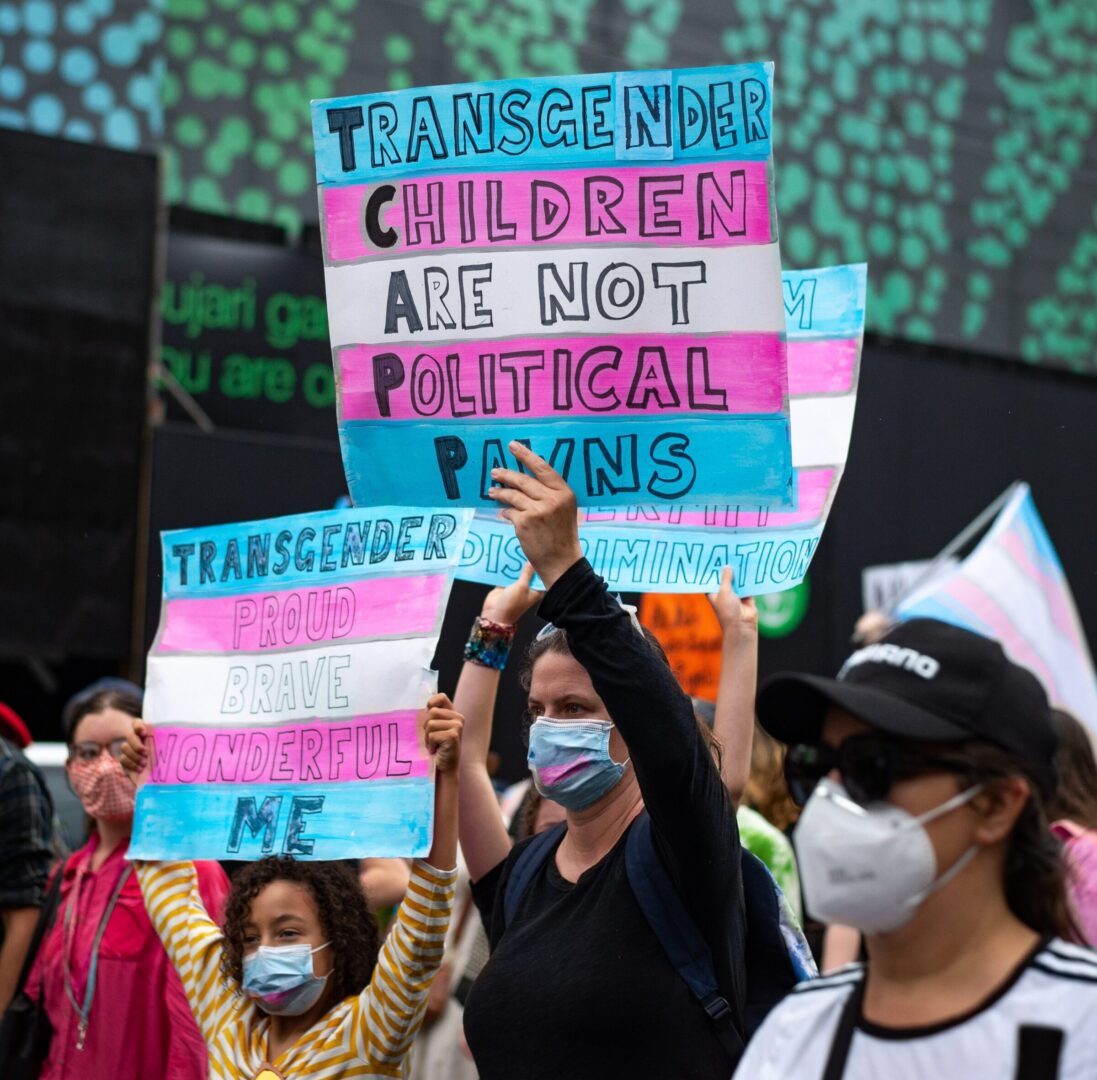 View Winners →
View Winners → 
Nov13 – Nov. 19 is Transgender Awareness Week, a time dedicated to uplifting the transgender community and spreading awareness of its struggles.
Nov. 20 marks Transgender Day of Remembrance to honor the memory of the transgender people who lost their lives through anti-transgender violence. In 1998, Rita Hester, a Black, transgender woman, was murdered in her home. Almost two decades later, police still have not found Rita’s murderer (or murderers).

According to a 2021 study by UCLA Williams Institute, School of Law, transgender people are four times more likely than cisgender people to experience violence, including rape, sexual assault, and aggravated or simple assault. That same year, at least 57 transgender or gender non-conforming people were fatally shot or killed by other violent means.
Superficially, Americans and their legislators accept and understand LGBTQ+ individuals more now than even a decade ago. The Supreme Court’s 2015 decision to legalize same-gender marriage stands as of the most tangible and significant wins for LGBTQ+ rights—yet the 2015 ruling only directly protected cisgender lesbian, gay, and bisexual individuals.
At least 19 states in 2016 considered bathroom bills, legislation that would force every person to use the gendered restroom matching the gender listed on their birth certificate. North Carolina passed this legislation, igniting conversations across the country and empowering lawmakers to draft similar bills in other states. But sister bills struggled to pass, and even North Carolina has since repealed its bathroom bill.
Several congressional representatives have turned to gender legislation to target transgender youth.
Stacker took a look at state-by-state data on sexual orientation and gender identity policies that affect transgender youth from the Transgender Law Center.
All 50 states and Washington D.C. were then ranked by their total “policy tallies” (the number of laws and policies driving equality for LGBTQ+ people), with #51 being the most restrictive state and #1 being the most protective state of trans youth. Negative tallies mean more discrimination laws exist than protection laws.
TLC’s policy tally accounts only for passed legislation and does not take into account activism efforts, attitudes, and feelings expressed by people in the state, nor implementations of these laws. The core categories TLC considered revolve around relationships and parental recognition, nondiscrimination, religious exemptions, LGBTQ+ youth, health care, criminal justice, and identity documents.
TLC’s findings capture how trans youth remain protected or vulnerable by statutory law, but legislation is elastic and lawmakers introduce new bills constantly. One category of these rankings only captures laws pertaining to sexuality since significant overlap exists within the queer community and within the legislation. Many lesbian, gay, or bisexual individuals also identify as transgender, nonbinary, or gender nonconforming, meaning LGBTQ+ individuals can identify with more than one queer identity.
Since 2020, anti-trans youth legislation claiming to protect children popped up more frequently in state legislatures, entering the more mainstream lexicon in 2021. During the first three months of 2022, lawmakers filed about 240 anti-LGBTQ+ laws—most of which targeted trans people.
Tennessee, the top state for anti-trans youth legislation, in 2017 signed a bill into law preventing trans children from receiving gender-affirming care. It was the fifth anti-trans law to pass in the state. Bills like these claim to protect parents and children, yet lawmakers in Tennessee are also considering a bill that would establish common-law marriages in the state between “one man and one woman” while eliminating age restrictions for marriage.
While anti-trans youth legislation outnumbers legislation to protect trans youth, several states have enacted or are considering laws intended to protect trans children. California has gone so far as to introduce a bill to accept families escaping anti-trans youth legislation. Colorado—formerly known as the “Hate State” for its history of passing anti-LGBTQ+ legislation throughout the ’90s—passed legislation banning conversion therapy, prohibiting bullying based on LGBTQ+ identities, and ending discrimination against LGBTQ+ families adopting children. Hawaii passed legislation in March that would require health insurance companies to pay for gender-affirming care—but not until 2060.
Note: this report is from April 2022, before many more anti-trans and anti-LGBTQ+ legislation. Visit freedomforallamericans.org to track nationwide legislation as it passes.
#51. Tennessee
– Overall tally: -6
– Gender identity policy tally: -5.75
– Sexual orientation policy tally: -0.25
#50. Arkansas
– Overall tally: -5.5
– Gender identity policy tally: -5
– Sexual orientation policy tally: -0.5
#49. South Dakota
– Overall tally: -4.5
– Gender identity policy tally: -4
– Sexual orientation policy tally: -0.5
#48. Alabama
– Overall tally: -4
– Gender identity policy tally: -3.5
– Sexual orientation policy tally: -0.5
#47. Mississippi
– Overall tally: -3.5
– Gender identity policy tally: -3
– Sexual orientation policy tally: -0.5
#46. Oklahoma
– Overall tally: -3
– Gender identity policy tally: -5
– Sexual orientation policy tally: 2
#45. Louisiana
– Overall tally: -2.5
– Gender identity policy tally: -3.5
– Sexual orientation policy tally: 1
#43. Georgia (tie)
– Overall tally: -0.5
– Gender identity policy tally: -3
– Sexual orientation policy tally: 2.5
#43. South Carolina (tie)
– Overall tally: -0.5
– Gender identity policy tally: -1.5
– Sexual orientation policy tally: 1
#42. Texas
– Overall tally: 0.5
– Gender identity policy tally: -2.25
– Sexual orientation policy tally: 2.75
#41. Missouri
– Overall tally: 0.75
– Gender identity policy tally: -2.75
– Sexual orientation policy tally: 3.5
#40. Wyoming
– Overall tally: 1.75
– Gender identity policy tally: -0.75
– Sexual orientation policy tally: 2.5
#39. Arizona
– Overall tally: 2.25
– Gender identity policy tally: -3.5
– Sexual orientation policy tally: 5.75
#38. Idaho
– Overall tally: 3.75
– Gender identity policy tally: -0.5
– Sexual orientation policy tally: 4.25
#35. Montana (tie)
– Overall tally: 4
– Gender identity policy tally: -0.5
– Sexual orientation policy tally: 4.5
#35. Nebraska (tie)
– Overall tally: 4
– Gender identity policy tally: -1.25
– Sexual orientation policy tally: 5.25
#35. West Virginia (tie)
– Overall tally: 4
– Gender identity policy tally: -1.5
– Sexual orientation policy tally: 5.5
#33. Florida (tie)*
– Overall tally: 5.75
– Gender identity policy tally: 2
– Sexual orientation policy tally: 3.75
this report is before the recent anti-trans legislation in Florida*
#33. North Carolina (tie)
– Overall tally: 5.75
– Gender identity policy tally: 1
– Sexual orientation policy tally: 4.75
#32. Indiana
– Overall tally: 6.5
– Gender identity policy tally: 1.25
– Sexual orientation policy tally: 5.25
#31. Kansas
– Overall tally: 7.75
– Gender identity policy tally: 3
– Sexual orientation policy tally: 4.75
#30. Ohio
– Overall tally: 9.75
– Gender identity policy tally: 3.75
– Sexual orientation policy tally: 6
#29. Kentucky
– Overall tally: 10.25
– Gender identity policy tally: 3
– Sexual orientation policy tally: 7.25
#28. North Dakota
– Overall tally: 11.75
– Gender identity policy tally: 4.25
– Sexual orientation policy tally: 7.5
#27. Utah
– Overall tally: 14.25
– Gender identity policy tally: 6.25
– Sexual orientation policy tally: 8
#26. Pennsylvania
– Overall tally: 15.5
– Gender identity policy tally: 9.25
– Sexual orientation policy tally: 6.25
#25. Iowa
– Overall tally: 17
– Gender identity policy tally: 6
– Sexual orientation policy tally: 11
#24. Alaska
– Overall tally: 17.75
– Gender identity policy tally: 9
– Sexual orientation policy tally: 8.75
#23. Wisconsin
– Overall tally: 18
– Gender identity policy tally: 5.25
– Sexual orientation policy tally: 12.75
#22. Michigan
– Overall tally: 19
– Gender identity policy tally: 11.25
– Sexual orientation policy tally: 7.75
You may also like: Oldest cities in America
#21. Delaware
– Overall tally: 25.25
– Gender identity policy tally: 12.75
– Sexual orientation policy tally: 12.5
#20. Virginia
– Overall tally: 26
– Gender identity policy tally: 14.5
– Sexual orientation policy tally: 11.5
#19. New Hampshire
– Overall tally: 27.5
– Gender identity policy tally: 14
– Sexual orientation policy tally: 13.5
#18. New Mexico
– Overall tally: 28
– Gender identity policy tally: 14.5
– Sexual orientation policy tally: 13.5
#17. Maryland
– Overall tally: 29.75
– Gender identity policy tally: 16.5
– Sexual orientation policy tally: 13.25
#16. Hawaii
– Overall tally: 31
– Gender identity policy tally: 16
– Sexual orientation policy tally: 15
#15. Rhode Island
– Overall tally: 32.5
– Gender identity policy tally: 16
– Sexual orientation policy tally: 16.5
#13. Massachusetts (tie)
– Overall tally: 33.5
– Gender identity policy tally: 17.25
– Sexual orientation policy tally: 16.25
#13. Minnesota (tie)
– Overall tally: 33.5
– Gender identity policy tally: 18.25
– Sexual orientation policy tally: 15.25
#12. Illinois
– Overall tally: 35
– Gender identity policy tally: 18
– Sexual orientation policy tally: 17
#10. Washington D.C. (tie)
– Overall tally: 36
– Gender identity policy tally: 19
– Sexual orientation policy tally: 17
#10. Vermont (tie)
– Overall tally: 36
– Gender identity policy tally: 18.5
– Sexual orientation policy tally: 17.5
#9. Oregon
– Overall tally: 36.5
– Gender identity policy tally: 19.5
– Sexual orientation policy tally: 17
#8. Washington
– Overall tally: 36.75
– Gender identity policy tally: 20
– Sexual orientation policy tally: 16.75
#6. Maine (tie)
– Overall tally: 37
– Gender identity policy tally: 18.5
– Sexual orientation policy tally: 18.5
#6. New Jersey (tie)
– Overall tally: 37
– Gender identity policy tally: 20
– Sexual orientation policy tally: 17
#5. Connecticut
– Overall tally: 37.5
– Gender identity policy tally: 20
– Sexual orientation policy tally: 17.5
#4. Nevada
– Overall tally: 38
– Gender identity policy tally: 20.5
– Sexual orientation policy tally: 17.5
#3. New York
– Overall tally: 39
– Gender identity policy tally: 20.5
– Sexual orientation policy tally: 18.5
#2. California
– Overall tally: 39.25
– Gender identity policy tally: 20.75
– Sexual orientation policy tally: 18.5
#1. Colorado
– Overall tally: 39.5
– Gender identity policy tally: 20.75
– Sexual orientation policy tally: 18.75
Re-published with CC BY-NC 4.0 License.








































































































